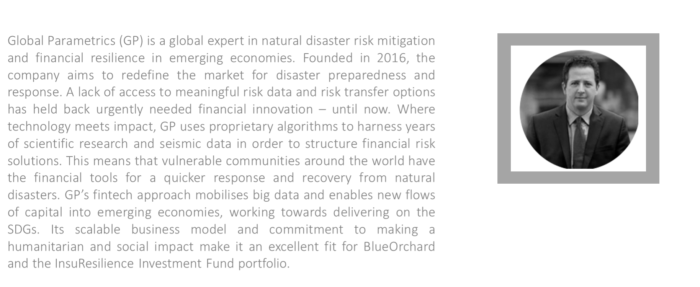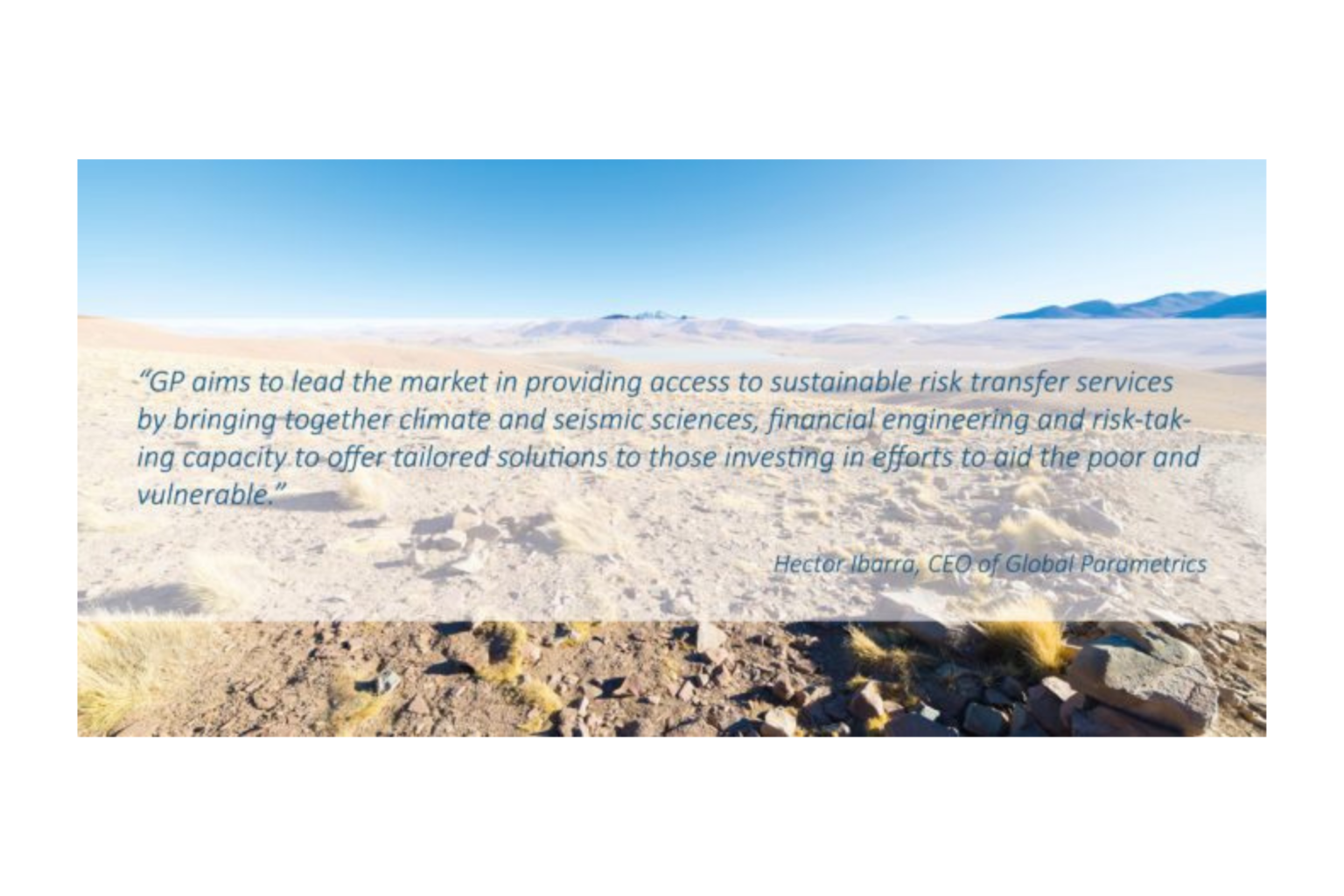
Hector, what is GP’s story?
Hector: GP has a unique business model designed to fill the massive gap for risk models and financial protection against disaster risks in low and middle-income countries (LMICs). GP aims to lead the market in providing access to sustainable risk transfer services by bringing together climate and seismic sciences, financial engineering and risk-taking capacity to offer tailored solutions to those investing in efforts to aid the poor and vulnerable, as expressed in its mission statement set out below: “We constantly innovate to design tailored and socially-oriented financial disaster risk management (FDRM) solutions that combine rigorous data, scientific research and financial engineering to support our clients serving the poor and vulnerable in low and middle-income countries. We build market-leading tools that empower our clients to increase their impact in areas vulnerable to disasters, including the continuation of services when climate or seismic disasters strike which, in turn, accelerates economic growth and reduces poverty and conflict.”
Why does Global Parametrics focus on mitigation and financial resiliance and what is your main target group?
Hector: GP’s mission statement emerges from GP’s belief that the lack of active markets for disaster risk insurance inhibits investment in LMICs, in turn hurts the poor and vulnerable who suffer the most when there is a natural disaster. This “missing market” contributes to greater volatility and increases the cost of capital, slows economic development, contributes to poverty and increases the potential for conflict. GP systematically identified constraints that have slowed market development in LMICs and developed a plan for “end-to-end solutions” to address these constraints. Some key constraints that shaped GP’s approach and continue to drive its strategies include: Data and risk models: an essential and missing information product in most LMICs; Legal and regulatory environment: major challenges exist for developing innovative financial structures in LMICs; High prices for insurance: complicated regulatory environments and lack of data lead to heavy loading on pricing resulting in higher pricing for coverage in LMICs than for coverage of the same risks in a developed country; and Limited familiarity: many potential buyers have little experience with insurance, or insurance-like financial products, that effectively limits demand. GP’s “end-to-end” business approach incorporates elements that address each of these short-comings: proprietary risk models, a specialized financial structuring and origination function, a fund manager (GPL) and patient risk capital (via NDF (UK) LP (the NDF). Experience in attempting to sell natural disaster insurance within LMICs has been disappointing at best. Many attempts have been made at the micro level, which often have required significant upfront and ongoing investment from donors with at times limited potential for scale and long-term sustainability. Some more promising models have been launched at the sovereign level but still a vast gap in the market exists to transfer natural disaster risk exposures that often impact the poor and vulnerable the most. With this landscape in mind, GP’s approach focuses on the untapped opportunity sets at the meso level within LMICs. Target clients at the meso-level include investors, businesses and institutions that invest or operate in LMICs
What is the benefit of your products for vulnerable communities in emerging markets?
Hector: In the years 1995–2010, natural disasters affected 3.6 billion people and caused USD 1 trillion losses. Given demographic and climate change trends, the level of insurance penetration is lowest where vulnerability is most acute. 93% of people living in extreme poverty are in countries that are politically fragile and/or environmentally vulnerable and, on average, in the period 1990-2016 94% of economic losses from natural catastrophes in low-and-middle-income countries were not insured. Through GP’s focus upon meso-level investors, businesses and institutions investing or operating in LMICs, GP works to ensure the continuity and growth, even when a natural disaster strikes, of much needed support for the poor and vulnerable provided by such meso-level clients: whether through financing their businesses, purchasing their goods, employing them, or providing the basic utilities and resources to maintain their livelihoods. These types of meso-level clients offer GP the opportunity to reach scale more quickly and promote more efficient structured financial solutions due to the more sophisticated counterparties.
What is your biggest USP that differentiates Global Parametrics from competitors?
Hector: Given the “missing market” that GP is seeking to develop and the “end-to-end” business approach adopted by GP in order to address the market constraints across LMICs, GP is quite distinct from other actors who are active within the various market segments across which GP operates (e.g. modelling, structuring, risk transfer etc). As such GP seeks to be more complementary rather than competitive and, accordingly, has been well received by both the market, clients/potential clients and development agencies and has established strong strategic relationships with risk transfer industry players that are ready to commit risk capital on the basis of GP’s own underwriting and pricing.
How does the use of technology provide opportunities in the fact of natural disasters?
Hector: The GP strategy begins by addressing the data and modeling gap with a unique, global Risk Hazard Platform that leverages publicly available global climate and seismic models and allows for innovative analysis in any country in the world. GP models weather risk using the same methods to: 1) create a historic data set back to the 1960s, 2) develop real-time data, and 3) forecast important weather variables for up to nine months. As one example of innovation, by forecasting extreme events prior to their onset (i.e. drought, floods, tropical cyclones) GP plans to offer forecast products that pay before the event. GP is able to offer parametric trigger products, based on customized indexes developed from GP’s Risk Hazard Platform, which pay out based on pre-agreed terms in the event of a disaster. The data generated by the Risk Hazard Platform underpins all of GP’s activities and enables GP to develop a better-informed view of the underlying risk to assets.
How are BlueOrchard and the InsuResilience Investment Fund helping your growth?
Hector: The Insuresilience Investment Fund (IIF) has provided invaluable financial support to GP as a cornerstone investor together with the UK Government’s Department for International Development (DFID). Both DFID and IIF have invested further capital into GP in late 2019 as GP positions itself to raise a Series A investment round in late 2020/early 2021. GP has also had the benefit of support from IIF appointees to its board of directors since its establishment and is very pleased to now be working with Alex Vleming in this capacity. IIF is also actively helping GP to explore potential opportunities for collaboration with other investees within its investment portfolio and GP values, and very much looks forward to deepening, such links.
What are your next milestones in terms of growth? And what is your vision for the company for the next years in terms of size and impact?
Hector: GP remains in the phase of investing in its team and operations to grow its business and demonstrate its model with profitability still several years further on the horizon. Specifically GP is building out its sales force, suring up its technology platform and investing in conducting a broad Series A fundraising campaign to be concluded by the end of 2020/early 2021. GP is set to grow its risk transfer activities significantly during the course of the next few years with revenue growth principally coming from the following three key areas: (i) Asset Management Fees: these are fees paid directly by the NDF to GP as a percent of AUM; (ii) Structuring & Placement Fees: fees for product structuring and fees paid by 3rd party capital providers for limits originated by GP but not placed with NDF because they exceed the capacity or because they do not fit the mandate; and (iii) Data & Advisory Fees: fees paid by clients for tailored information and advisory services that leverage GP’s risk hazard platform. Also looking forward, GP recognizes that its risk hazard platform and the product development with GP algorithms can be used for any set of geographies and exposures in the world and, as such, it is anticipated that GP’s generation of “benchmark” indexes will distinguish GP globally and will allow it to expand its activities well beyond the confines of the risk transfer sector. The GP team seeks to measure impact generated from its products and services for the benefit of vulnerable communities. GP management believes that its approach will change behavior in how investments flow into LMICs aimed at building resilience and environmental adaptation. GP’s demonstration of this alternative approach is expected to lead to further market developments in LMICs that will enhance economic development, lower rates of poverty and reduce conflict. This market development and transformation is the principal objective of GP – as an ambitious objective, GP anticipates leveraging all its business partners to scale rapidly and achieve market reform.
Thank you, Hector, for answering our questions.
